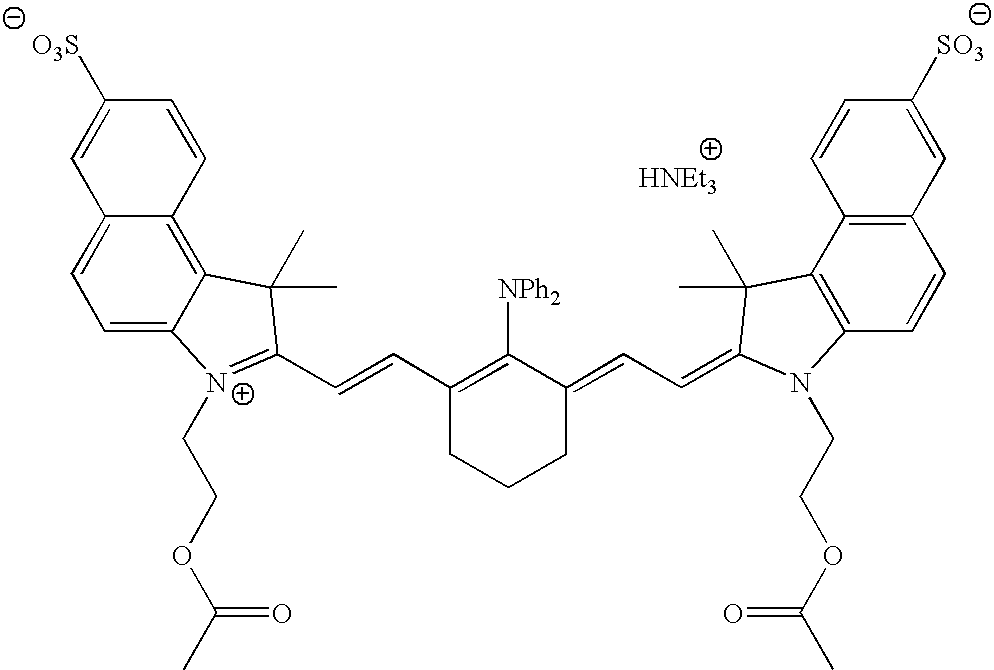On-press developable imageable element comprising a tetraarylborate salt
a technology of tetraarylborate salt and developable image elements, which is applied in the field of imageable elements, can solve the problems of high cost of a developer, increased processing costs of the imaged element in the developer, and increased labor costs for operating the process, so as to improve the adhesion, improve the imaging speed, and enhance the life of the press
- Summary
- Abstract
- Description
- Claims
- Application Information
AI Technical Summary
Benefits of technology
Problems solved by technology
Method used
Image
Examples
examples
[0124]
Glossary of Chemicals Used in Synthesis of Copolymers and in CoatingFormulationsBYK 336:Modified dimethyl polysiloxane co-polymer in a 25% xylene / methoxypropyl acetatesolution, available from Byk-Chemie USA Inc. (Wallingford, Connecticut)DESMODUR N100:Aliphatic polyisocyanate resin based on hexamethylene diisocyanate, availablefrom Bayer Corp. (Milford, Connecticut)DMBzTB:N-(4-Benzoylbenzyl)-N,N,-dimethylbenzylammonium tetraphenylborate,prepared according to W. Zhang, K. Feng, X. Wu, D. Martin, and D. C. Neckers,J. Org. Chem. 1999, 64, 458–463ELVACITE 4026:10 wt.-% solution in 2-butanone of a highly-branched poly(methyl methacrylate)available from Lucite International, Inc. (Cordova, Tennessee)HNBu3BPh4:Tributylammonium tetraphenylborate, prepared according to F. E. Crane,Anal. Chem. 1956, 28, 1794–1797IR Dye:The IR dye used in coating formulations is represented by the formula:IRGACURE 250:75 wt.-% solution of (4-methoxyphenyl)[4-(2-methylpropyl)phenyl] iodoniumhexafluorophos...
examples e21
, E22 and Comparative Example C9
[0143]For each of Examples E21, E22, and Comparative Example C9, a coating composition was prepared according to the formulation set forth in Table 4 (given quantities include solvent fractions of the various components), using the borate compound indicated in Table 7. Each composition was slot-coated onto Substrate S1 at 2.5 mL / ft2 and dried at 120° F. to yield a precursor.
[0144]The precursors were imaged on a Creo TRENDSETTER 3244 at a fixed laser power while varying the drum speed such that a series of solid images were formed at exposures ranging from 39 to 293 mJ / cm2. The imaged precursors were mounted on a Komori SPRINT 26 offset printing press without further processing. The press was charged with Equinox Process Black ink (Graphic Ink Company, Inc., Salt Late City, Utah) and fountain solution containing Vam Litho Etch 142W at 3 oz. / gal. and PAR alcohol replacement at 3 oz. / gal. After printing about 500 to 700 copies the press was stopped.
[0145...
examples e35
and E36
[0155]For each of Examples E35 and E36, a coating composition was prepared according to the formulation set forth in Table 11 (given quantities include solvent fractions of the various components). Each composition was coated onto Substrate S1 and dried to provide a coating weight of 0.88 g / m2, producing a precursor.
[0156]
TABLE 11Formulations for coating compositions used in Examples E35 and E36.Parts by WeightComponentExample E35Example E36Copolymer N4.89—Copolymer E—5.04ELVACITE 40261.931.93Urethane Acrylate1.111.11SR 3991.111.11IRGACURE 2500.180.18IR Dye0.150.15NBu4BPh40.150.15Mercapto-3-triazole0.110.11BYK 3360.350.35KLUCEL M3.863.86n-Propanol54.7154.59MEK17.0517.05Water14.4014.67
[0157]The precursors were subjected to accelerated aging at 38° C. and 80% relative humidity for 5 days.
[0158]Precursors for Example E35 were imaged on a Creo TRENDSETTER 3230 at 10 W laser power at 158 and 79 rpm (corresponding to exposures of 150 and 300 mJ / cm2, respectively). Precursors for Ex...
PUM
| Property | Measurement | Unit |
|---|---|---|
| wavelength ranges | aaaaa | aaaaa |
| wavelength ranges | aaaaa | aaaaa |
| wavelength ranges | aaaaa | aaaaa |
Abstract
Description
Claims
Application Information
 Login to View More
Login to View More - R&D
- Intellectual Property
- Life Sciences
- Materials
- Tech Scout
- Unparalleled Data Quality
- Higher Quality Content
- 60% Fewer Hallucinations
Browse by: Latest US Patents, China's latest patents, Technical Efficacy Thesaurus, Application Domain, Technology Topic, Popular Technical Reports.
© 2025 PatSnap. All rights reserved.Legal|Privacy policy|Modern Slavery Act Transparency Statement|Sitemap|About US| Contact US: help@patsnap.com

